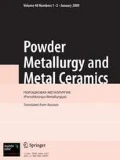Conclusions
-
1.
The more remote the process of hydrogen reduction of tungsten and molybdenum from equilibrium and the more unstable the intermediate phases, the greater is the self-acceleration of the reduction process resulting from particle comminution.
-
2.
The hypothesis is advanced thatβ-W is a granulometric rather than a temperature modification of tungsten, which means that the existence ofβ-W directly depends on the particle size of the material.
Similar content being viewed by others
Literature cited
A. V. Savin, Poroshkovaya Met., No. 9 (1968).
A. V. Savin, N. D. Smirnov, and L. S. Vodop'yanova, Poroshkovaya Met., No. 7 (1971).
A. Hegedus, T. Millner, et al., Z. Anorg. Allgem. Chem.,281, No. 1–2, 64 (1955).
Author information
Authors and Affiliations
Additional information
Published to stimulate discussion.
Deceased.
Translated from Poroshkovaya Metallurgiya, No. 7(151), pp. 6–10, July, 1975.
Rights and permissions
About this article
Cite this article
Chizhikov, D.M., Savin, A.V., Safonov, V.I. et al. Reduction of tungsten and molybdenum oxides. Powder Metall Met Ceram 14, 521–524 (1975). https://doi.org/10.1007/BF00810983
Received:
Issue Date:
DOI: https://doi.org/10.1007/BF00810983



